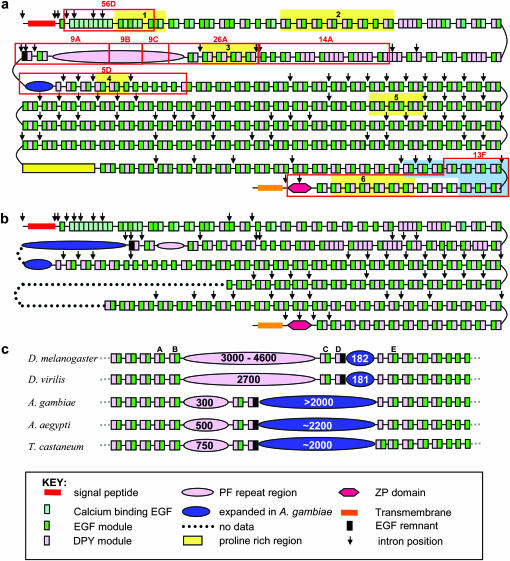Figure 1.—
Comparison of the complete modular structure of D. melanogaster with that of An. gambiae, as well as a comparison across insects of the modular structure in the vicinity of the PF region. (a) The modular structure of D. melanogaster Dumpy is adapted from Wilkin et al. (2000). The majority of Dumpy is extracellular and composed of EGF domains (green rectangles) and a novel 21-amino-acid, four-cysteine module DPY (pink rectangles). Also marked as a black rectangle is a remnant EGF domain. Near its C terminus there is a single ZP domain depicted with a red hexagon. There are two main regions of low complexity sequence, one near the N terminus, shown in pink and referred to as the PF repeat region, and a second much nearer to the C terminus that is the proline-rich region. Shown as a blue ellipsoid is a charged proline-, serine-, threonine-rich spacer region. (b) The predicted modular structure of An. gambiae is basically identical to that of D. melanogaster in the region sequenced, except in the locality of the PF region, which has contracted, and in the large spacer region, which has expanded. (c) An enlargement of the vicinity of the PF region from D. melanogaster, D. virilis, An. gambiae, Ae. aegypti, and T. castaneum; numbers indicate the numbers of amino acids in the PIGSFEAST region. The modular structure of the DPY and EGF domains is conserved (except in T. castaneum, which has an extra EGF module following the region that is expanded in An. gambiae). In Drosophila, the PF region is expanded, and the adjacent spacer region is not, whereas in the mosquito and the red flour beetle, the reverse is true. In a, the regions demarcated by red boxes are the positions of subclones used for reverse Southern blots. The areas highlighted in yellow are utilized in Table 2 to assess the conservation of the dumpy gene across species. The region highlighted in blue marks the position of digoxygenin-labeled RNA probe used to detect dumpy in ovaries. In c, the positions of the DPY–EGF domains are marked to confirm the organization of the PF region in divergent species as discussed in the results.

